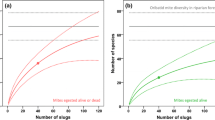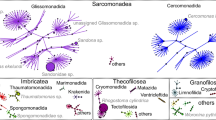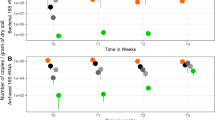Abstract
Due to their high abundance and ubiquitous existence, microbes are considered to be efficient colonisers of newly established habitats. To shed light on the dispersal mechanisms of soil microbes, a controlled microcosm experiment was established. In these microcosms, the dispersal of microbes from a source humus patch to originally sterile humus patches (embedded in a mineral soil matrix) was followed for 16 months, applying 16S and 18S ribosomal DNA-based PCR-DGGE molecular methods. Specifically, the role of enchytraeid worms and habitat (humus) corridors as possible facilitators of microbe dispersal was studied. The results showed that enchytraeid worms function efficiently as vectors for horizontal dispersal of saprophytic fungi in soil. Some of the fungi also proved to disperse through the corridors by vegetative growth, although this dispersal was inefficient as compared to dispersal with the enchytraeids. Virtually no saprophytic fungi were able to disperse through the mineral soil matrix in the absence of both enchytraeid worms and corridors. Unlike soil fungi, the dispersal of soil bacteria was not affected by any of the studied factors. The results of the present experiment provide direct evidence of the crucial role of soil fauna in aiding the horizontal dispersal of soil fungi. The role of enchytraeids as a functionally important species in boreal forest soils is further emphasized, since bringing microbes into contact with new resources is likely to enhance the rate of decomposition in soils.



Similar content being viewed by others
References
Allen MF (1991) The ecology of mycorrhizae. Cambridge University Press, Cambridge
Brown JH, Kodric-Brown A (1977) Turnover rates in insular biogeography: effect of immigration on extinction. Ecology 58:445–449
Bruns TD (1995) Thoughts on the processes that maintain local species diversity of ectomycorrhizal fungi. Plant Soil 170:63–73
Chapin FS III, Walker BH, Hobbs RJ, Hooper DU, Lawton JH, Sala OE, Tilman D (1997) Biotic control over the functioning of ecosystems. Science 277:500–504
Coleman DC, Crossley DA Jr (1996) Fundamentals of soil ecology. Academic Press, San Diego
Didden WAM (1990) Involvement of Enchytraeidae (Oligochaeta) in soil structure evolution in agricultural fields. Biol Fertil Soils 9:152–158
Dighton J, Thomas ED, Latter PM (1987) Interactions between tree roots, mycorrhizas, a saprotrophic fungus and the decomposition of organic substrates in a microcosm. Biol Fertil Soils 4:145–150
Dighton J, Jones HE, Robinson CH, Beckett J (1997) The role of abiotic factors, cultivation practices and soil fauna in the dispersal of genetically modified microorganisms in soils. Appl Soil Ecol 5:109–131
Doube BM, Stephens PM, Davoren CW, Ryder MH (1994) Interactions between earthworms, beneficial soil microorganisms and root pathogens. Appl Soil Ecol 1:3–10
Dromph K (2001) Dispersal of entomopathogenic fungi by collembolans. Soil Biol Biochem 33:2047–2051
Gange AC (1993) Translocation of mycorrhizal fungi by earthworms during early succession. Soil Biol Biochem 25:1021–1026
Gilbert F, Gonzalez A, Evans-Freke I (1998) Corridors maintain species richness in the fragmented landscapes of a microecosystem. Proc R Soc Lond B 265:577–582
Gonzalez A, Lawton JH, Gilbert FS, Blackburn TM, Evans-Freke I (1998) Metapopulation dynamics, abundance, and distribution in a microecosystem. Science 281:2045–2047
Haimi J, Siira-Pietikäinen A (2003) Activity and role of the enchytraeid worm Cognettia sphagnetorum (Vejd.) (Oligochaeta: Enchytraeidae) in organic and mineral forest soil. Pedobiologia 47:303–310
Haimi J, Fritze H, Moilanen P (2000) Responses of soil decomposer animals to wood-ash fertilisation and burning in a coniferous forest stand. For Ecol Manage 129:53–61
Hedlund K, Augustsson A (1995) Effects of enchytraeid grazing on fungal growth and respiration. Soil Biol Biochem 27:905–909
Heijden MGA van der , Klironomos JN, Ursic M, Moutoglis P, Streitwolf-Engel R, Boller T, Wiemken A, Sanders IR (1998) Mycorrhizal fungal diversity determines plant biodiversity, ecosystem variability and productivity. Nature 396:69–72
Heuer H, Krsek M, Baker P, Smalla K, Wellington EMH (1997) Analysis of actinomycete communities by specific amplification of genes encoding 16S rRNA and gel-electrophoretic separation in denaturing gradients. Appl Environ Microbiol 63:3233–3241
Huhta V (1984) Response of Cognettia sphagnetorum (Enchytraeidae) to manipulation of pH and nutrient status in coniferous forest soil. Pedobiologia 27:245–260
Kaye JP, Hart SC (1997) Competition for nitrogen between plants and soil microorganisms. Trends Ecol Evol 12:139–143
Klironomos JN, Moutoglis P (1999) Colonization of nonmycorrhizal plants by mycorrhizal neighbours as influenced by the collembolan, Folsomia candida. Biol Fertil Soils 29:277–281
Laakso J, Setälä H (1999) Sensitivity of primary production to changes in the architecture of belowground food webs. Oikos 87:57–64
Lipson D, Näsholm T (2001) The unexpected versatility of plants: organic nitrogen use and availability in terrestrial ecosystems. Oecologia 128:305–316
MacDonald DW, Johnson DDP (2001) Dispersal in theory and practice: consequences for conservation biology. In: Clobert J, Danchin E, Dhondt AA, Nichols JD (eds) Dispersal. Oxford University Press, New York, pp 358–372
Mahmood S, Finlay RD, Erland S, Wallander H (2001) Solubilisation and colonisation of wood ash by ectomycorrhizal fungi isolated from a wood ash fertilised spruce forest. FEMS Microbiol Ecol 35:151–161
Martin A, Marinissen JCY (1993) Biological and physico-chemical processes in excrements of soil animals. Geoderma 56:331–347
O’Connor FB (1962) The extraction of Enchytraeidae from soil. In: Murphy PW (ed) Progress in soil zoology. Butterworths, London, pp 279–285
Pennanen T, Fritze H, Vanhala P, Kiikkilä O, Neuvonen S, Bååth E (1998) Structure of a microbial community in soil after prolonged addition of low levels of simulated acid rain. Appl Environ Microbiol 64:2173–2180
Pennanen T, Paavolainen L, Hantula J (2001) Rapid PCR-based method for the direct analysis of fungal communities in complex environmental samples. Soil Biol Biochem 32:697–699
Perkiömäki J, Fritze H (2002) Short and long-term effects of wood ash on the boreal forest humus microbial community. Soil Biol Biochem 34:1343–1353
Richards BN (1987) The microbiology of terrestrial ecosystems. Longman UK, Singapore
Setälä H (2000) Reciprocal interactions between Scots pine and soil food web structure in the presence and absence of ectomycorrhiza. Oecologia 125:109–118
Setälä H, Tyynismaa M, Martikainen E, Huhta V (1991) Mineralization of C, N and P in relation to decomposer community structure in coniferous forest soil. Pedobiologia 35:285–296
Shearer CA (1995) Fungal competition. Can J Bot 73 (Suppl 1):S1259–S1264
Siira-Pietikäinen A, Haimi J, Fritze H (2003) Organisms, decomposition, and growth of pine seedlings in boreal forest soil affected by sod cutting and trenching. Biol Fertil Soils 37:163–174
SPSS (2000) SPSS for Windows, release 10.1. SPSS, Chicago, Ill.
Stotzky G (1997) Soil as an environment for microbial life. In: Van Elsas JD, Trevors JT, Wellington EMH (eds) Modern soil microbiology. Marcel Dekker, New York, pp 1–20
Sulkava P, Huhta V, Laakso J (1996) Impact of soil faunal structure on decomposition and N-mineralisation in relation to temperature and moisture in forest soil. Pedobiologia 40:505–513
Vainio EJ, Hantula J (2000) Direct analysis of wood-inhabiting fungi using denaturing gradient gel electrophoresis of amplified ribosomal DNA. Mycol Res 104:927–936
Visser S (1988) Role of the soil invertebrates in determining the composition of soil microbial communities. In: Fitter AH, Atkinson D, Read DJ, Usher MB (eds) Ecological interactions in soil: plants, microbes and animals. Blackwell Scientific, Oxford, pp 297–317
Williams RG, Whipps JM, Cooke RC (1998) Role of soil mesofauna in dispersal of Coniothyrium minitans: transmission to sclerotia of Sclerotia sclerotionum. Soil Biol Biochem 30:1929–1935
Zar JH (1999) Biostatistical analysis, 4th edn. Prentice Hall, New Jersey
Acknowledgements
We thank Leena Kontiola for helping in the assembly of the microcosms and samplings, MaryAnn McLean for providing the cultures of saprophytic soil fungi, Martin Romantschuk for providing the cultures of bacteria and Mika Räty for identifying the enchytraeid worms. The Soil Group at the University of Jyväskylä is acknowledged for invaluable comments on the manuscript. This work was supported by the Academy of Finland [Project number 47946: “Habitat fragmentation and performance of decomposer communities—linking the mechanisms affecting diversity of soil decomposer organisms to tree growth” as part of the Finnish Biodiversity Research Programme, FIBRE (2000–2002)].
Author information
Authors and Affiliations
Corresponding author
Rights and permissions
About this article
Cite this article
Rantalainen, ML., Fritze, H., Haimi, J. et al. Do enchytraeid worms and habitat corridors facilitate the colonisation of habitat patches by soil microbes?. Biol Fertil Soils 39, 200–208 (2004). https://doi.org/10.1007/s00374-003-0687-1
Received:
Accepted:
Published:
Issue Date:
DOI: https://doi.org/10.1007/s00374-003-0687-1




